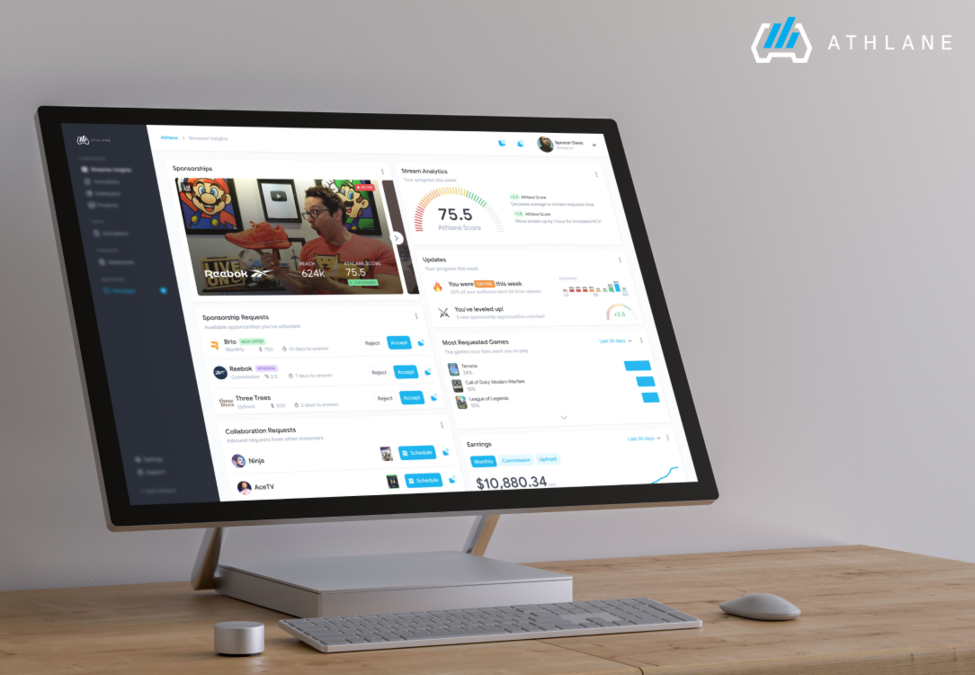It’s no secret that revenue from sponsorships makes up a considerable chunk of the esports industry’s economy.
In July, esports analytics provider Newzoo estimated that sponsorships would generate almost 60 percent of the industry’s revenue, and today their significance is probably as prevalent as it ever has been before – with the cancellation of live events that would be ticketed or otherwise used as a vehicle to sell merchandise.
Whilst the majority of sponsorship deals concern esports events and competitive organisations, a growing number of professional players and content creators are beginning to access endorsement deals. Although the process of securing sponsorships has traditionally been achieved through marketing or talent agencies, Athlane – a sponsorship platform backed by Tyler “Ninja” Blevins and Jonathan Kraft – has plans to simplify sponsorships for professional players and content creators alike.

Following Athlane’s $3.3M seed investment this July, we spoke with Ryan Jiang, VP of Product at Athlane, to discuss how the company intends to forge a new path in the sponsorship sector.
Esports Insider: Online, Athlane has been described as a sponsorship brokerage, but one could also suggest that the business fulfils the role of a talent agency as well. Could you clarify Athlane’s position in the market?
Ryan Jiang: I know there have been a lot of players in the space that start off as a platform or an agency and have probably used the one to accelerate the other. We are definitely a platform first, but in order to build the platform we have found it necessary to manage some of the influencer marketing programs. Reebok – one of our clients – asked us to start an influencer marketing program for them in esports, an industry they had never entered before, and at the time our platform wasn’t nearly as robust so we had to manage a lot of manual work and spreadsheets almost like a pseudo agency.
In the long-term – and even the medium term, really – we’re looking to completely take a step back from that kind of manual work. We’re trying to make it super easy, even for someone without an esports background to find streamers and partner with them.
ESI: In July, Jessica and Tyler “Ninja” Blevins contributed to Athlane’s seed investment alongside several sporting giants. How exactly did the involvement of these latter two investors occur?
RJ: Ninja is getting more and more into investment and he has some pretty big plans, so we got the opportunity to pitch to him and explain that our goal is to democratise the access of sponsorships for streamers so more people can get access and make a career from streaming. Ninja bought into this idea and he has been really supportive of what we have been doing and he appears excited about the prospects we have been identifying.
ESI: Considering their experience, do you hope that Jessica and Ninja will play an active role in Athlane?
RJ: I would say there are a lot of different philosophies that startups can take and I personally would say that Athlane follows this philosophy: when you get an investor, you want that person to be a part of your journey. They own a part of the company and so their wins become your wins. A lot of people have money so when you have a good team and a good idea – which we do – it isn’t hard to find investors. In fact, we had to turn down the majority of people looking to invest, so you really want to find people who can actually provide value. Ninja and Jessica have definitely been very active, we’ll have regular calls with them and they’re doing a lot on our behalf as well.
ESI: Unlike many other organisations who connect brands with streamers and professional esports athletes who create side content, Athlane puts a significant emphasis on technology. Could you tell us more about how Athlane is integrating machine learning and data to improve the effectiveness of sponsorships in esports?
RJ: We’re taking a very user-focused mindset of reducing down the noise to focus on what really matters so in a few clicks I can see what I need to. On the brand side, for example, I can see what the streamer is about and their analytics, and on the streamer side I can understand what the opportunity is and how easy it would be to execute on what a brand has asked me to do.
We also have auto-tracking built into the platform with a variety of different algorithms and machine learning to be on the lookout for different posts so streamers don’t have to worry about reporting or task completion, they just make a post and it’ll register appropriately on the website. We can then track the growth of posts over time as well and brands have access to similar tracking tools. We are basically trying to remove all the logistical headaches that come with partnerships like payments, billing and legalities so influencers can focus on making content.
I can go to TwitchTracker and see 50 different analytics pages but all those numbers, pages and charts mean nothing and they’re basically just squiggly lines that are useless. We would much rather have five numbers on a page that tell you 80% of the story than display all this visual clutter. On Athlane, streamers can see five things: three they have done well and two things they need to improve on, so we can work with our advisors like Ninja to really hone in on what goes into a streamer’s success.

ESI: It’s known that Athlane has signed a number of data deals with companies such as Twitter, as well as another undisclosed apparel company. Are these partnerships in place so Athlane is better able to understand audiences in esports?
RJ: Whilst I can’t share its specific name, the manufacturer of apparel is one of the biggest branded apparel companies in the esports space so they engage in partnerships with a whole linear of teams, players and whatnot. The primary goal of these partnerships is to achieve access to data that others may not be able to. So, for example, we’re looking into how we can enrich the customer demographic data with some of the purchase history data. This is obviously all generalised so we don’t get access to personal data, but at a high level it lets us see what types of users the apparel manufacturer has, what types of products they are buying and enables us to aggregate all this information to look at what they’re interested in and what type of general profile the users are.
Demographics is for sure a big part of what we’re doing, but in total, we’re constantly analysing a list of 100 or so variables and running statistics on them. We have a team of folks including one of the first Instagram engineers after their acquisition, we have a variety of people from Stanford, Harvard as well as a five year data scientist at Twitch. Our team is very technically competent, and what we will do is a ton of research on all the variables we’re tracking to help work out the most important things to present to brands and streamers.
ESI: Athlane has announced deals with Reebok, Brio, and VinPorter, three non-endemic organisations. Could you share some insight into how these partnerships have come about so far?
RJ: Sales have not been particularly difficult. Most brands, even those who haven’t entered the industry before, are interested because of the numbers. Twitch’s user base is up so much year over year and the gaming industry is growing so quickly. With the advent of State Farm and Red Bull being perennial sponsors and showing a lot of success, people are beginning to take notice and investing into platforms like TikTok and Twitch where the audience is younger.
I would say that the biggest differentiator is – let’s say you are working with Reebok in our case – where do you find a partner to help you enter the space? I think for us, because our investor network is inclusive of strong players in the gaming space like Ninja as well as being advised by traditional sportspeople from Kraft, for example, we have a strong holistic understanding of what traditional sports looks like, what actually matters when you’re entering a space like this and also getting the perspective of players from esports and how we succeed in the industry.


